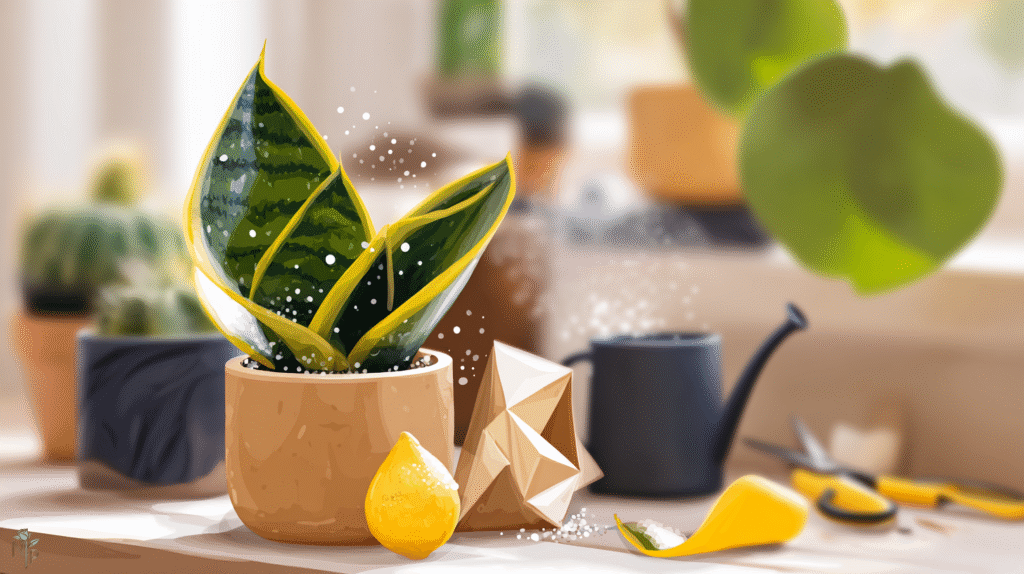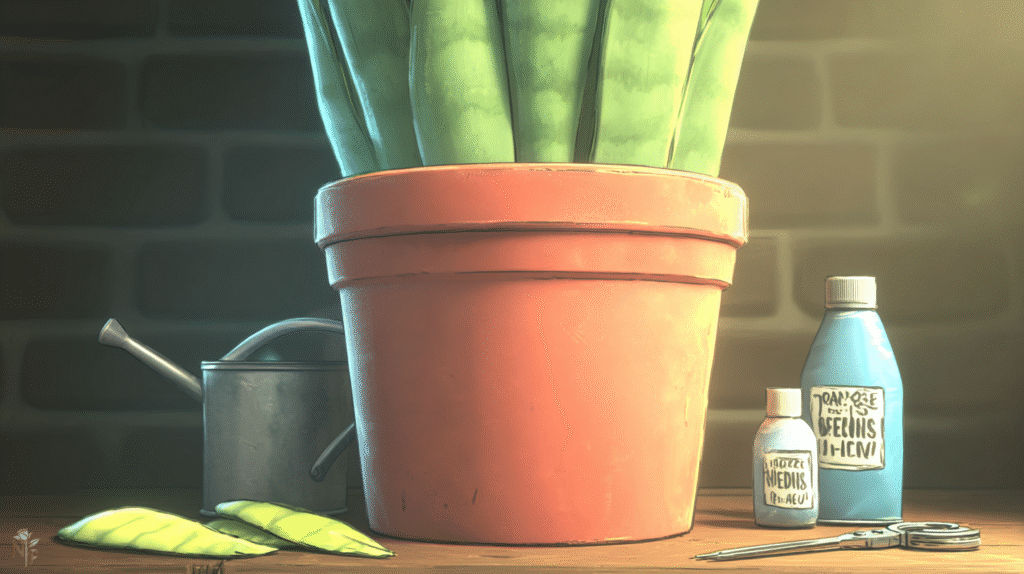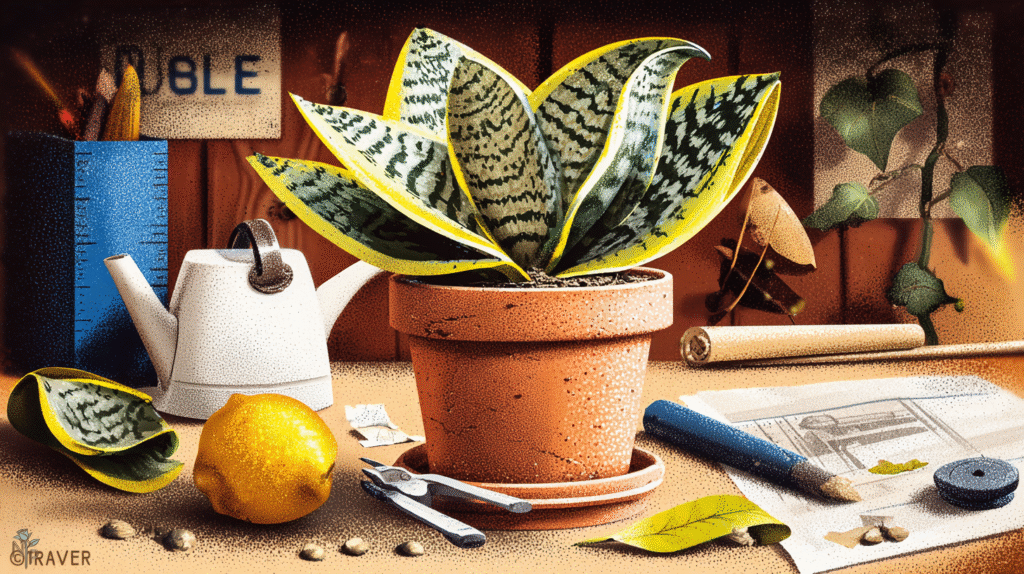“You can’t kill a snake plant,” they said. “They thrive on neglect,” they promised.
Tell that to the three mushy, yellow disasters I composted before finally understanding what was going wrong. Turns out, snake plants aren’t unkillable — they’re just really good at hiding their problems until it’s almost too late. By the time you notice something’s wrong, your “indestructible” plant is already plotting its dramatic exit.
After murdering multiple snake plants and finally keeping eight thriving for over two years, I’ve become a snake plant detective. Every yellow leaf, every soft spot, every lean tells a story. Here’s how to read the signs before your snake plant becomes another casualty of the “unkillable” myth.
The Slow Decline Nobody Warns You About
Snake plants don’t die dramatically like a peace lily (instant wilting) or a fittonia (fainting at the mere thought of dry soil). They die slowly, quietly, maintaining their dignity until the very end. This makes diagnosis tricky.
My first snake plant looked fine for two months while actively dying. Still standing upright, still green-ish, still looking like a plant. Then one day I touched a leaf and it fell off. The base? Complete mush. It had been rotting for weeks while pretending everything was fine.
That’s the snake plant way — suffer in silence until it’s too late. But once you know what to look for, you can catch problems while they’re still fixable.
The #1 Killer: Overwatering and Root Rot
Let’s start with what murders 90% of snake plants: too much love in the form of water.
Early warning signs:
- Leaves feel softer than usual (healthy leaves are rigid)
- Slight yellowing starting from the base
- Soil stays moist for more than a week
- Musty smell from the pot
- Black spots at soil level
The progression I’ve witnessed multiple times: Week 1-2: Soil stays wet, plant looks normal Week 3-4: Lower leaves start yellowing slightly Week 5-6: Leaves feel soft, some black at base Week 7-8: Total collapse, roots completely rotten
How to check: Gently wiggle a leaf. Does it feel loose? Bad sign. Carefully unpot and check roots. Healthy roots are white/orange and firm. Rotting roots are black, mushy, and smell like defeat.
The fix if caught early:
- Remove from pot immediately
- Cut off all black/mushy roots
- Trim affected leaves at base
- Let dry for 24 hours
- Repot in dry, well-draining soil
- Don’t water for at least a week
I’ve saved two snake plants this way. The key is acting fast once you spot the signs.

The Sneaky Problem: Underwatering
“But I thought they liked neglect!” Yes, but there’s neglect and there’s abandonment. I learned this distinction the hard way.
Signs of underwatering:
- Leaves wrinkling or curling inward
- Brown, crispy tips (not soft brown)
- Leaves feel thin and papery
- Soil pulls away from pot edges
- Growth completely stalled
My office snake plant went four months without water during busy season. Didn’t die, but looked terrible — wrinkled, brown-tipped, generally disappointed in my life choices. The recovery took months.
The fix:
- Water thoroughly until it drains
- Don’t shock with too much at once
- Resume normal watering schedule
- Trim brown tips at an angle
- Be patient — recovery is slow
Light Issues: The Gradual Decline
Snake plants tolerate low light, but “tolerate” and “thrive” are different things. My snake plant light experiment taught me this.
Too little light symptoms:
- Leaves lose variegation (yellow edges turn green)
- New growth is thin and weak
- Excessive leaning toward light source
- Years without new growth
- Dark green turns pale green
Too much light problems:
- Bleached, washed-out appearance
- Brown patches (sunburn)
- Leaves curl to protect themselves
- Crispy edges
My bedroom snake plant in the dark corner survived three years but never grew a single new leaf. Moved to medium light? Four new shoots in six months.
Temperature and Draft Damage
Snake plants are tougher than most houseplants, but they have limits. I discovered these limits during one brutal winter.
Cold damage signs:
- Scarring on leaves
- Soft, water-soaked appearance
- Black spots that spread
- Sudden yellowing after cold exposure
Heat stress indicators:
- Leaves splitting
- Brown edges
- Excessive water needs
- Stunted growth
My snake plant by the drafty window developed black scars after a cold snap. Moved away from the window, it recovered but those scars are permanent reminders.
Pest Problems: Rare But Real
Everyone says snake plants don’t get pests. Everyone is wrong. They’re just less susceptible than other plants.
Spider mites:
- Fine webbing between leaves
- Stippled, damaged appearance
- Dusty-looking leaves
Mealybugs:
- White cotton-like clusters
- Usually where leaves meet
- Sticky residue
Scale:
- Brown bumps on leaves
- Sticky honeydew
- Yellowing around infected areas
My worst infestation came from a new plant I didn’t quarantine. Mealybugs spread to three snake plants before I caught it. Now I check every new plant like a paranoid plant parent.

Soil and Pot Problems
Wrong soil kills slowly but surely. I learned this after losing a beautiful variegated snake plant to regular potting soil.
Signs of soil issues:
- Water sits on surface
- Soil stays wet forever
- Algae growing on soil
- Fungus gnats appearing
- General decline despite good care
Pot problems:
- No drainage = death sentence
- Too big = soil stays wet too long
- Too small = rootbound stress
The fix is simple: well-draining cactus soil and pots with drainage holes. No exceptions.
Age and Natural Decline
Sometimes leaves die because they’re old. This freaked me out until I learned it’s normal.
Natural aging signs:
- Outer leaves yellowing
- One leaf at a time
- Plant otherwise healthy
- New growth appearing
My oldest snake plant loses 1-2 outer leaves yearly. Totally normal. The panic stops once you recognize the pattern.
Environmental Stress Factors
Repotting shock: Snake plants hate change. After repotting, they might sulk for weeks. Yellow leaves, no growth, general grumpiness. Usually resolves with time.
Fluoride sensitivity: Brown tips that won’t stop? Might be tap water. Some snake plants are sensitive to fluoride. Switching to filtered water fixed my persistent brown tip problem.
Ethylene gas: That snake plant in your kitchen declining? Could be ethylene from ripening fruit. Moved mine away from the fruit bowl — problem solved.
Your Diagnostic Checklist
When your snake plant looks unhappy:
- Check moisture: Stick finger deep in soil
- Examine leaves: Soft? Crispy? Discolored?
- Look at location: Too dark? Too cold? Near hazards?
- Inspect for pests: Check where leaves meet
- Consider recent changes: Repotting? Season change?
- Evaluate pot/soil: Drainage working? Soil appropriate?
Prevention: Better Than Cure
After all my snake plant murders, here’s what keeps them thriving:
- Water only when soil is completely dry
- Use cactus soil mixed with perlite
- Provide medium to bright indirect light
- Keep away from drafts and vents
- Check monthly for pests
- Don’t move them unnecessarily
- Accept that some leaf loss is normal

The Bottom Line
Snake plants aren’t unkillable — they’re just slow to show problems. By the time symptoms appear, issues are often advanced. But armed with this knowledge, you can catch problems early.
My current eight snake plants thrive because I learned their subtle language. That slight softness in a leaf? I’m checking roots. Tiny bit of yellowing? Investigating immediately. They’re actually quite communicative once you know what to look for.
The myth of the indestructible snake plant does more harm than good. They’re resilient, yes, but not immortal. Respect their needs, watch for early warning signs, and they’ll outlive us all. Just maybe don’t believe the “thrives on neglect” hype. They tolerate neglect — there’s a difference. 🐍






